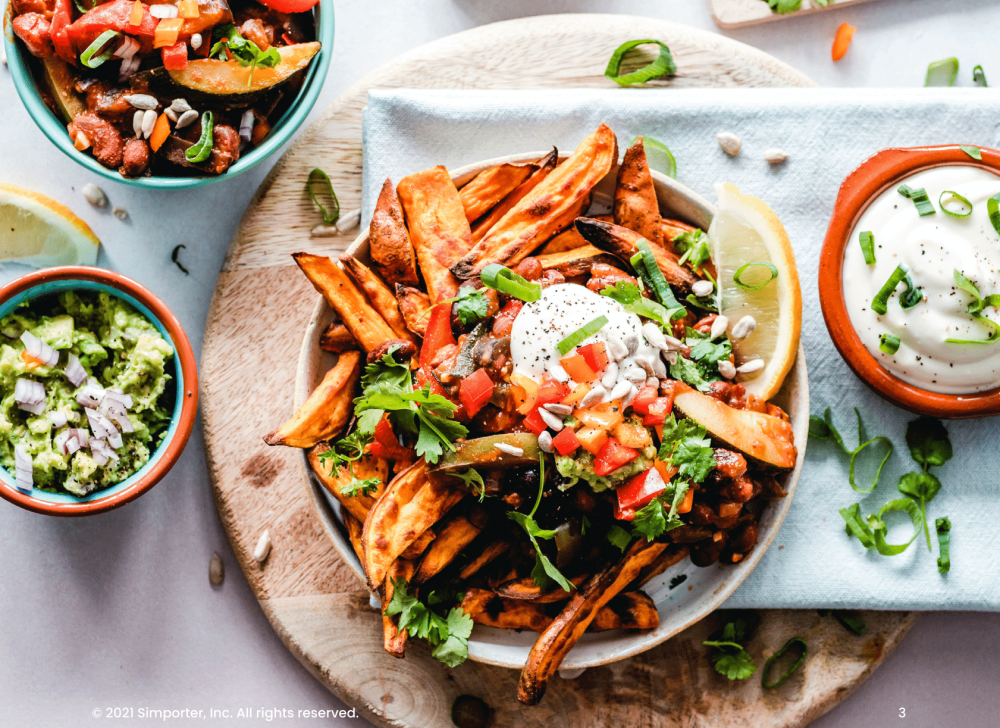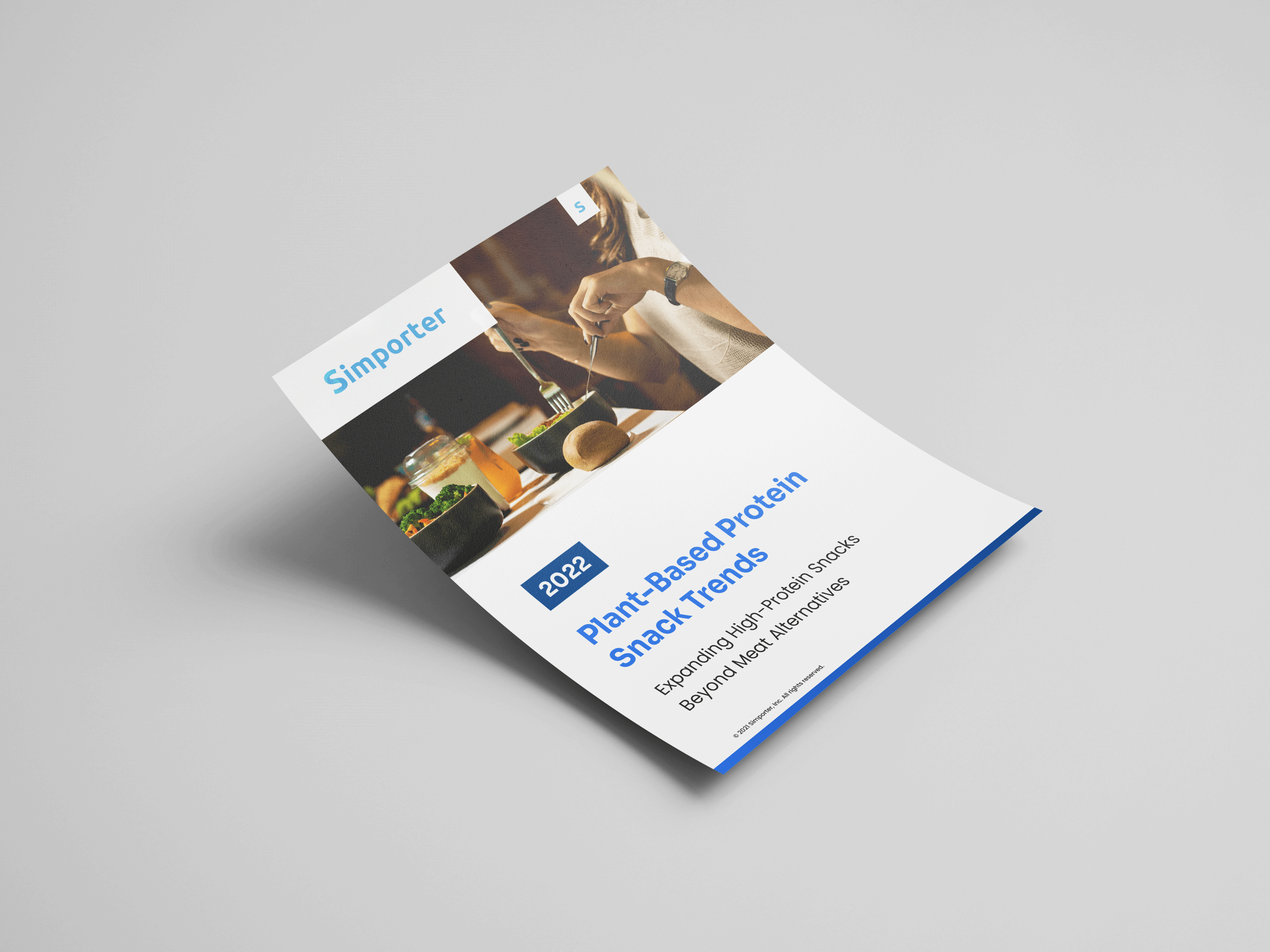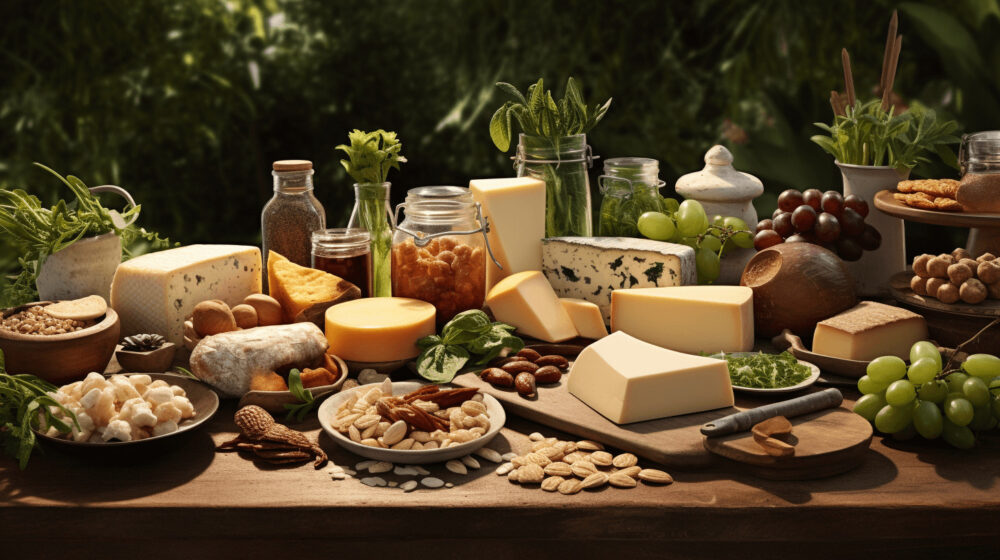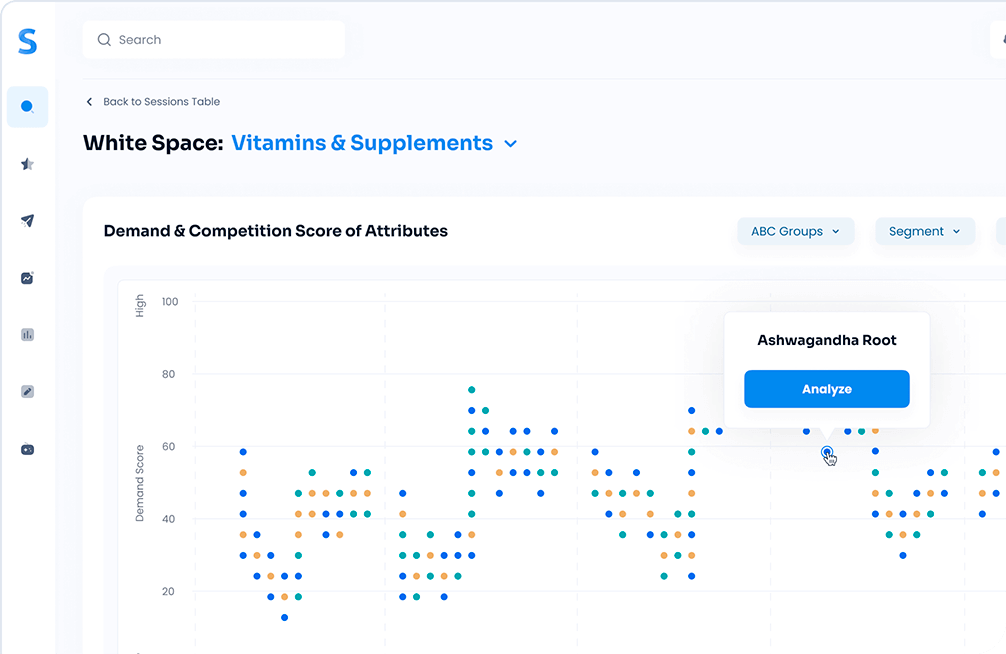Expanding High-Protein Snacks Beyond Meat Alternatives
Introduction
The future seems brighter than ever for plant-based protein suppliers.
The pandemic sparked fresh awareness in healthy eating and more customers began exploring (and appreciating) plant-based products during the lockdown. It also brought about a huge cultural shift towards more frequent snacking.
As a result, protein-rich and plant-based snacks are in high demand. Americans are opting for more plant-based meals because they believe it’s the healthier choice. And those that value those health benefits carry that with them as they prioritize more nutritious snacks. Plant-based protein snacks, in particular, are growing due to their ability to satiate hunger and replace meals.
At Simporter, we recognized the emergence of the plant-based protein trend and wanted to more deeply explore the impact of COVID-19 on the market. Through this exploration, we would be able to prepare for a shift in consumer attitudes and to discover trends and opportunities to act on throughout the next year and into 2022. To carry this out, we combined the intelligent automation of Whitespace AI and the skills of expert data analysts and identified the three fastest-growing trends for the plant-based protein market:
- Consumers are wanting more plant-based, high-protein ingredients in their snack foods, including lentils and mushrooms, which offer high mineral and vitamin content.
- The uptick in health trends and keto diets due to COVID have pushed consumers to want easy health. Meaning healthy, nutrition-rich and convenient snacks.
- That doesn’t mean they don’t want their comfort food or traditional quick bites. Consumers want better options for cereals, chips, and meat alternative snacks.
Data Analyzed for this Report
For this report, we used our WhiteSpace AI platform to collect and analyze over 2,200 products, 1.7 million mentions, and 528 brands. We analyzed consumer interest for every relevant keyword phrase across tens of thousands of reviews, descriptions, Google search results, and consumer mentions on social media.
We then scored the level of consumer interest for each keyword phrase by cross-analyzing:
- Search frequency
- The volume of social media posts
- Sentiment
- Mentions
- Competition
This tool is used to capture white spaces around ingredients, need states, and sensory attributes in a category in real-time. It helps identify which attributes that consumers actively search for but cannot find so companies can include them in their development pipeline.
We aggregate this data to come up with a “Mentions” market share rate to measure how much share an attribute holds compared to all other search terms. The “Mentions Growth” rate is a year-over-year rate that shows how much the term has grown or declined yearly across channels.
Each keyword phrase was scored by its competitive levels and consumer need state. Scores are categorized based on opportunity, known as the “opportunity score.” We rate attributes such as benefits, ingredients, and types of snacks from Very Low to Low, Average, High, to Very High.
What Are Plant-Based Proteins?
Plant-based protein is defined as a finished product consisting of ingredients derived from plants. This includes vegetables, whole grains, nuts, seeds, legumes, and fruits. Plant proteins are used to provide alternatives to animal protein, eggs, and dairy products.
Vegans and vegetarians are traditionally thought of as the highest consumers for plant proteins, but as research indicates, the desire for more sustainable, environment-friendly, and healthy-minded foods is becoming mainstream.

Why the Growing Demand for Plant-Based Protein Products?
According to the Plant-Based Foods Association, the yearly retail food industry rose by 2.2 percent in 2019, but plant-based foods climbed by 11.4 percent.
Walk into any organic or health-food grocery store, or at least the health-food section, and you’ll find almond milk-based cheese, tofu-based sour cream, plant protein cookies, and a countless array of meatless burgers, sausages, chicken, meatballs — the list goes on. The list is growing, too. Fast.
Consumers look to plant-based protein for a combination of reasons, including:
- Sustainable and environmentally friendly nutrition. Consumers are increasingly making their food choices based on sustainability and environmental impact. There’s been a major push in recent years to highlight the environmental and health effects associated with meat production and consumption.
- Support health and biohack the body. In the US, 39 percent of consumers are trying to eat more plant-based foods due to the increasing evidence that plants are better for the body than meat and dairy products. For example, plant protein is associated with a lower risk of cardiovascular disease mortality.
- Increase protein intake to support an active lifestyle and build muscle. Protein builds lean muscle mass and provides a feeling of fullness that can aid in weight loss. In recent years, the rise of diets like keto and paleo, which push for high protein and low carbs, have helped drive protein demand.
- Reduce allergic or inflammatory reactions. Over 12 million people suffer from a food allergy in the US. More than a majority of food allergies are caused by eggs, milk, fish, and red meat. These allergies are pushing consumers to try meat substitutes made of plant protein.
Ingredients, Benefits, and Snack Types: Choose Your Own Winning Combination
The global plant-based protein is projected to grow at a compound annual growth rate (CAGR) of 14.1 percent. Hence the market size of $18.49 billion is estimated to reach $40.58 billion by 2026.
With so much at stake, Simporter decided to look at 72,000 consumer data points to score plant-based protein attributes across search terms, social mentions, reviews, and a host of more data. We discovered the following trends for top snack types, benefits, and ingredients that consumers are demanding. We’ll go into more detail in the following sections.

Top Ingredients
Consumers are on the lookout for unique, high-protein ingredients. Mushrooms scored very high on our opportunity scale, along with lentils. Soy protein isolates also scored high.
- Mushrooms were reported to only hold .86 percent of mentions market share but had a 524 percent growth rate year-over-year in mentions
- Lentils held a .21 percent market share and a 233 percent growth rate
- Soy protein isolate held a 20.97 percent share and 15 percent growth rate
Top Benefits
We found that consumers look for a number of benefits out of their high-protein plant-based snacks as well. For year-over-year growth in mentions:
- Vitamins as a benefit group have seen a growth rate of 29 percent
- The keto-friendly benefit group have seen a growth rate of 25 percent
- The convenience benefit group have seen a 16 percent growth rate, with 36.66 percent of the market share
Top Snack Types
Plant-based protein snacks are now available in many forms such as cookies, powders, bars, chips, meat alternatives, shakes, and cereals. Of these, Simporter found cereals, meat alternatives, and chips are the highest growing forms of plant-based protein snacks.
- Cereals reported a 174 percent growth rate
- Meat alternatives have seen a 109 percent growth rate
- Chips have seen a 64 percent growth rate

Protein-Rich Plant Ingredients Do Exist
Lentils
Lentils are nutritional powerhouses. They are cholesterol-free, sodium-free, and low-fat. They are loaded with minerals and key nutrients like potassium, folate, iron, and fiber. And protein is the best part. Lentils provide at least 18 grams of protein per cup — the same as a serving of tofu. To acquire that much of the vitamin, you’d have to consume an entire can of chickpeas.
Mushrooms
Popular species of edible mushrooms (e.g. baby bella, oyster, porcini, portabella, and shiitake) are 19-35 percent protein, which is high when compared to rice, wheat, milk, and soybean proteins. Mushrooms also consist of a rich composition of vitamins, antioxidants, minerals, and polyunsaturated fatty acids.
What’s interesting about mushrooms is that they possess a high branched-chain amino acid (BCAA) composition similar to an animal-based protein source that provides the same protein quality as in meat. This makes it a superior ingredient for plant-based protein snacks.
Soy Protein Isolate
Consumers looking to achieve a high-protein diet look to soy because of its concentrated protein content — 23g per 1 oz. It has one of the highest scores on digestibility and amino acid balance for all alternative proteins and a neutral taste profile, making it a versatile ingredient for snack manufacturers.
Consumers Want Healthy and Convenient
Keto-Friendly Options
A ketogenic diet is a high fat, moderate protein, low carb diet that forces the body into a state of ketosis.
Despite the keto diet being seemingly easier for those who eat animal protein, our data showed that keto-friendly plant-based protein snacks have a very high opportunity for success with a 25 percent growth in mentions year-over-year.
Vegans and vegetarians still experience success using the diet by focusing on high-protein, high-fat foods like nuts, seeds, oils, avocados, full-fat coconut milk, and soybean-based products like tofu and tempeh. But when it comes to snack products, keto-friendly and vegan-friendly options don’t always go hand in hand. That leads us to the next benefit consumers want to see from their plant protein snacks: convenience.
Convenience
Cooking fatigue has settled in for many consumers especially as workplaces and schools open back up. And what comes with these reopenings is the pre-COVID normalcy of commutes and more hectic schedules. People want easy. They want convenience. But they still want their protein.
As a result of a global uptick in plant-based protein sales, there are many brands such as HighKey, Popcorners, Moku, Munk Pack, and many others that are carving their way through space with unique snack product offerings and capitalizing on the long-term growth opportunities presented.
For example, HighKey has its plant-based protein cereal, which offers 10 grams of protein per serving. Popcorners Flex protein chips also pack in 10 grams, and Munk Pack cookies punch in at 16 grams of protein per serving.
Vitamins
It’s not enough to offer high protein content. Consumers want to know what else a food product does for them. Incorporating key vitamins will meet consumers’ concerns for boosting energy, improving digestive health, and increasing healthy fat intake.
Plant-based diets benefit greatly from vitamins A, D, B12, and long-chain omega 3 fatty acids. Probiotics and prebiotics are also in high demand. All of these create the potential for manufacturers to add critical elements to plant-based protein snacks and address consumer health concerns. Exciting plant-based milk prototypes, for example, harness the inherent goodness of oats while also fortifying them with omega-3 (DHA) from marine plants and vitamin B12, all essential ingredients for brain development.

The New Go-To Snack Categories
Cereals
One out of every five young adults currently eats breakfast on the go, and 40 percent of cereal consumers in the US think that cereal should be more portable. This is a significant opportunity for cereal manufacturers to market themselves as snack-friendly. Despite the fact that cereal is commonly associated with breakfast, over half of customers eat it as a snack. This is especially true for younger customers.
Additionally, many people believe that breakfast is the most essential meal of the day and believe that a morning meal should provide long amounts of energy and fullness. Cereals, particularly those marketed as snacks, should be designed to be more energetic and satisfying in order to suit these customer demands. Plant-based protein is one way to satisfy the urge for extended satiety while also distinguishing a brand’s product.
Chips
Oily snacks are on the decline. Consumers are swapping high-sodium and high-fat (the bad kind), and high-carb for healthier alternatives. That doesn’t mean snack food like chips are going away. Consumers are gravitating towards snacks that contain fruit, nuts, seeds, oats, whole grains, and other ingredients, indicating that they still want the classic crunchy sensations, just a better protein-filled version.
Protein chips not only help to neutralize cravings, but they are also a good source of protein and low carbs. As a result, protein chips become the greatest option for consumers who require a high-protein meal on the go to meet their immediate protein needs. The protein chips market is predicted to increase rapidly as a result of these factors.
Meat Alternatives
In Simporter’s white paper, Keto-Friendly Snacks Trends for 2022: The Surprising New Opportunities for Cereals and Meat Snacks, we found that when it came to traditional meat snacks (jerky, sticks, etc.), “vegan” was the highest category with a 425 percent growth rate in mentions year-on-year.
Though “vegan meat snacks” might be one of the biggest oxymorons ever, when it comes down to it, vegans, or anyone who wants to cut down on meat intake, also want a quick and easy way to satisfy food cravings without diving off into the carb-filled deep end. And with advances in cellular agriculture and molecular engineering, it’s becoming compoundingly easier to create products that better mimic the flavor and texture of traditional animal meat.

Conceptualizing Plant-Based Protein Snacks
With all this data, what’s next? Simporter’s data analysts and marketers work with companies to come up with worthy concepts and products that have the most potential to bring in high profits. Here are a couple of examples of how we took the plant-based protein snack data and turned it into theoretical examples of new products:
- Puffed Lentils with Himalayan Salt and B Vitamins
The potato chips market was valued at $22.10 billion in 2020 and is projected to increase up to $31.18 billion by 2028.
In order to grasp the larger opportunity in the chip category, brands could introduce a lentil-based snack puff fortified with vitamins and minerals, meeting the health concerns for many consumers around protein (lentils), sodium (Himalayan salt), and energy (B vitamins).
- Keto-Friendly Dried Shiitake Mushroom Nacho Chips
Vegan consumers are always looking for new ways to get more protein in their diets, especially those consumers that follow a keto lifestyle. Keto vegans also want food products that can satisfy their hunger and are safe for other food allergies.
Keto-friendly dried shiitake mushroom nacho chips would make for a powerhouse of a snack. Mushrooms help customers consume the same amino acids as meat while keto-based ingredients ensure a high-fat and high-protein profile.
About Simporter
Simporter was founded in 2018 with the mission to automate new product research. We believe that Artificial Intelligence is the biggest thing to happen to market research since surveys were created.
Together, our team consists of some of the most experienced CPG professionals, brightest data scientists, quickest software engineers, and the most technology-driven marketers.
We help major CPG brands create better products with data instead of human guesswork. Our mission is global, with our two main offices split between Atlanta and Kyiv.
Our team believes in four major values: honesty, hard work, proactivity, and automation. We hope to see you join us on our mission to automate new product research!
Ready to find your big idea to bring to market? Contact us today for a product demo.









